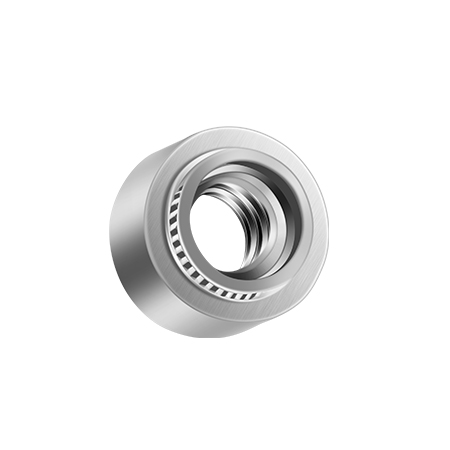A PEM clinch nut is a type of threaded fastener designed to be permanently installed into thin sheet metal or other materials through a cold-forming process. These nuts feature a knurled shank and a hexagonal or round base that deforms the host material during installation, creating a secure, vibration-resistant threaded connection without requiring welding or adhesives.
Key technical characteristics of standard Pem Clinch Nuts include:
Material: Typically carbon steel (SAE 1010/1018) with zinc plating (5-8µm) or stainless steel (AISI 304/316)
Thread sizes: Range from M2 to M12 (metric) or #2-56 to 1/2"-20 (UNC/UNF)
Installation force: 1.5-12 kN depending on size and material
Sheet thickness compatibility: 0.5-3.0 mm for most applications
Pull-out strength: 200-5000 N (varies with material and size)
Torque resistance: 1-25 Nm for standard versions

The knurled shank (typically with 25-35 teeth per inch) provides rotational resistance during installation and service, with testing showing >90% retention of installed torque after vibration testing per DIN 65151. The hexagonal base (across flats measuring 5.5-19 mm depending on size) prevents rotation during bolt tightening, capable of withstanding torque values up to 150% of standard specifications before deformation occurs.
Modern PEM Clinch Nuts achieve installation cycle times of 0.5-2 seconds in automated production environments. The temperature resistance ranges from -40°C to +120°C for zinc-plated versions and up to +800°C for stainless steel variants. Salt spray testing (ASTM B117) demonstrates 500+ hours of corrosion resistance for zinc-plated models in harsh environments.
PEM clinch nuts find extensive use in industries requiring reliable threaded fastening in thin materials:
Automotive: Body panels (0.8-1.2 mm steel), interior trim components, and electrical grounding points. Modern vehicles typically contain 50-200 clinch nuts for various attachments.
Electronics: Server racks (1.0-2.0 mm steel), PCB mounting frames, and enclosure assemblies where weld-free installation is critical for sensitive components.
HVAC Systems: Ductwork connections (0.6-1.5 mm galvanized steel) requiring vibration-resistant threads that maintain seal integrity.
Aerospace: Lightweight aluminum panels (1.2-2.5 mm) in non-structural applications, with specialized aluminum or titanium clinch nuts meeting MIL-SPEC requirements.
Medical Equipment: Stainless steel versions (AISI 316L) for cleanroom-compatible assemblies that withstand repeated sterilization cycles.
In industrial machinery, PEM clinch nuts provide removable access panels in control cabinets (1.5-3.0 mm steel) with typical service life exceeding 50 installation/removal cycles without thread degradation. The telecommunications sector utilizes them in 5G antenna housings where they demonstrate >15 year lifespan in outdoor environments.
Proper installation requires specific parameters to ensure optimal performance:
Installation Process:
Hole preparation: Precision punched or drilled holes with diameter tolerance of +0.05/-0.00 mm
Alignment: Nut must be perpendicular to workpiece within 2°
Force application: Hydraulic or pneumatic press with controlled stroke (typically 1.5-3.0 mm)
Inspection: Verify full material flow into knurling and proper flange seating
Maintenance protocols for installed clinch nuts include:
Annual visual inspection for corrosion (particularly in saltwater environments)
Thread cleaning with wire brushes (brass for steel nuts, nylon for aluminum)
Lubrication with dry-film lubricants (0.5-1.0 µm thickness) for high-cycle applications
Torque verification every 5-10 removal cycles using calibrated torque wrenches
For corrosion protection, zinc-nickel plating (12-15µm) provides 1000+ hours salt spray resistance. In high-vibration environments, thread-locking compounds (LOCTITE 243) can be applied, increasing vibration resistance by 300% while maintaining disassembly torque below 150% of installation value.
Replacement procedures for damaged nuts involve drilling out the clinch point (3-6 mm carbide bit for steel) and installing an oversize replacement nut (typically +1 thread size). For critical applications, eddy current testing can verify proper material flow after installation with >95% detection rate of insufficient clinch.
Previous: